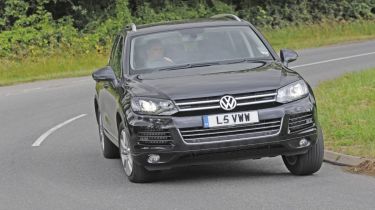VW Touareg 3.0 TDI SE
New 4x4 shares running gear with Porsche, but has a softer set-up
LINED up against the showy models in this test, the Volkswagen’s styling is very low-key. While this will undoubtedly appeal to some buyers, the new Touareg hasn’t taken a big step forward from its predecessor. In fact, despite being all-new, you could easily mistake it for the outgoing model.
Smart LED daytime running lights add a dash of style, but the soft lines look disappointing next to the chunky BMW, sporty Porsche and unique Infiniti. Inside, it’s a similar story, as owners of the current car hoping to see a big advance in quality and design will be disappointed.
The uninspiring cabin lacks the upmarket ambience of the Porsche, with which the Touareg shares its underpinnings. For a car in this price range, the VW simply doesn’t feel special enough. The glovebox lid is a prime example, as it’s made of harder and less attractive trim than the surrounding dashboard – and these unappealing plastics can be found in other places around the cabin as well.
Build quality is solid, but the dated design and mismatch of materials is a shame. However, the large eight-inch screen on the centre console is standard, while the duplicate display between the dials for the driver is a neat touch.
Used - available now

2020 Peugeot
508
57,957 milesAutomaticDiesel1.5L
Cash £11,999
2021 Ford
Fiesta
9,955 milesAutomaticPetrol1.0L
Cash £16,699
2023 Ford
Puma
18,363 milesAutomaticPetrol1.0L
Cash £16,899
2020 Ford
Kuga
24,644 milesAutomaticDiesel2.0L
Cash £25,799As in the Porsche, you get deep door pockets, decent cabin stowage and a wide range of adjustment for the driving position. The seats aren’t as supportive or comfortable over long distances as those in the Cayenne, but in SE models they’re heated as standard. Sat-nav is also included – both are options on the other German cars.
In the back, space is identical to the Porsche and the seats slide, tilt and fold in exactly the same manner. The 580-litre boot is 40 litres behind the BMW’s for overall luggage capacity.
While the cabin lacks the feelgood factor of its main rivals, there’s no faulting the VW’s pace. At the test track, the Touareg was fastest from 0-60mph, with a time of 7.1 seconds, and was closely matched to the X5 and Cayenne during our in-gear assessments.
As the VW and Porsche share the same V6 diesel and eight-speed Tiptronic auto box, their similar performance figures were predictable. But after driving them back-to-back, they clearly have different characters. The Touareg is less focused. Its handling is safe and composed, but the steering lacks the Cayenne’s precision. There’s also extra body roll and less grip during hard cornering, so the VW doesn’t feel as agile or involving.
The relatively soft suspension set-up delivers a supple ride around town, yet at higher speeds, it’s unsettled as the rear dampers struggle to cope.
Driven in isolation, the VW won’t disappoint, but in our line-up of sporty off-roaders, it’s outclassed. Only the Infiniti trails the Touareg dynamically, as the German 4x4 is more comfortable than its Japanese rival from behind the wheel.
Where the VW scores well is on economy and emissions, because, like the Porsche, it features a smooth stop/start system. This contributes to low CO2 emissions of 195g/km for such a fast and heavy vehicle, as well as decent fuel efficiency – we managed 29.7mpg on test. The Porsche and BMW have identical eco credentials, though, and returned better economy.
Details
Chart position: 3
WHY: As before, Touareg shares a platform, engine and some components with Porsche. It’s a cheaper alternative, but is it as good?







